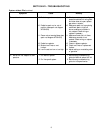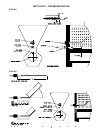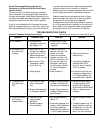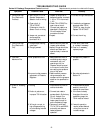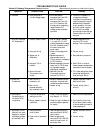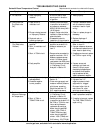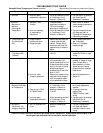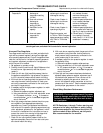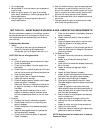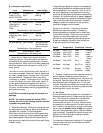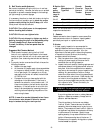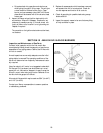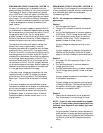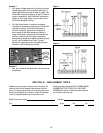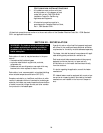
1. Turn off gas supply.
2. Set thermostat or controller above room temperature
to call for heat.
3. Watch for ignition spark or for glow at hot surface
igniter either immediately or following prepurge. See IP
module specifications.
4. Time the length of the spark operation. See the IP
module specifications.
5. After the module locks out, open the manual gas cock
and make sure no gas is flowing to the pilot or main
burner. With modules that continue to spark until the pilot
lights or the system shuts down manually, the pilot should
light when the manual gas control knob is opened.
6. Set the thermostat below room temperature and wait
one minute.
7. Operate system through one cmplete cycle to make
sure all controls operate properly
17
SECTION VIII - MAINTENANCE SCHEDULE AND LUBRICATION REQUIREMENTS
Periodic maintenance is essential to the efficient operation
and extended service life of this equipment. Failure to pro-
vide maintenance as recommended may void the equip-
ment warranty.
A. Maintenance Schedule
1. Weekly
a. Check that fan belts are tight and sheaves are
aligned.The fan belts can be checked every
30 days after the first 60 days of new belt run-in.
CAUTION: Do not overtighten belts.
2. Monthly
a. Check all valves, piping and connections for leaks.
b. Check the flame signal.
c. Check the fuel pressure in the fuel supply line to
each heater.
d. Check the burner manifold pressure at full fire and
that low fire has a continous flame all across burner.
e. Clean the flame sensor(s).
f. Inspect filters. Clean or replace as necessary.
g. Inspect the main fan bearings.
h. Check all dampers, damper actuators and linkages.
Adjust and tighten if necessary.
i. Ensure that there are no obstruction blocking the
air supply to the heater or the air discharge from
the heater.
j. Inspect the area and make sure that no com-
bustible or hazardous material has been stored
within the clearances as shown on the unit name-
plate.
3. Quarterly
a. Complete the monthly maintenance schedule.
b. Check the belt tension for the main fan(s) and
adjust if necessary.
c. Check the alignment of the sheaves and adjust if
necessary.
d. Inspect all bearings set screws for tightness and
lubricate bearings if necessary.
e. Check the pilot electrical system (if applicable).
Adjust if necessary.
f. Check the pilot assembly (if applicable). Clean and
adjust if necessary.
g. Inspect the burner carefully. Clean and adjust if
necessary.
h. Check voltages and amp draw on main fan motor.
i. Check the operation of all safety controls
individually.
j. Check the operation of the automatic gas shut off
valves and check them for leakage at the pressure
test ports provided.
4. Off Season or Yearly
a. Complete the monthly and quarterly maintenance
schedule.
b. Inspect all fan wheels and housings. Clean if
necessary.
c. Check that all fan wheels and sheaves are securely
set on the shaft.
d. Inspect all bearings and alignment.Adjust if
necessary.
e. Inspect all V-belts. Replace if necessary.
f. Inspect all electrical components, connections and
terminals. Clean and tighten where necessary.
g. Test ignition spark.Adjust gap if necessary.
h. Clean ignition electrodes and check for cracks.
i. Test flame safeguard relay and replace components
if necessary.
j. Inspect all regulators, relief valves, motorized
valves, solenoid valves, vent valves, manual shut off
valves and safety shut off valves. Check their oper-
ation and clean as necessary.
k. Ensure all vents to the atmosphere are clean and
free from obstruction.
l. Inspect and clean all drip legs in the fuel line.
m. Lubricate fan motor as directed by motor manu-
facturer.
n. Inspect fan motor wiring for loose connections.
o. Lightly oil all door latches.
p. Check that cabinet is weathertight, replace door
gaskets and recaulk as necessary.
NOTE: Keep screened air intakes clear of obstruc-
tions at all times.



